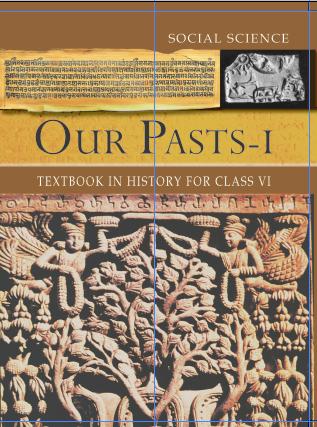
myCBSEguide App
Download the app to get CBSE Sample Papers 2024-25, NCERT Solutions (Revised), Most Important Questions, Previous Year Question Bank, Mock Tests, and Detailed Notes.
Install NowNCERT solutions for Class 6 Social Science History Ashoka the emperor who gave up war book solutions are available in PDF format for free download. These ncert book chapter wise questions and answers are very helpful for CBSE exam. CBSE recommends NCERT books and most of the questions in CBSE exam are asked from NCERT textbooks. Class 6 Social Science chapter wise NCERT solution for Social Science part 1 part 2 and Part 3 for all the chapters can be downloaded from our website and myCBSEguide mobile app for free.
NCERT Solutions for History Download as PDF

NCERT Class 6 Social Science Chapter Wise Solutions
History – Our Pasts Part I
- Chapter 1 – What, Where, How and when?
- Chapter 2 – On The Trial of the Earliest People
- Chapter 3 – From Gathering to Growing Food
- Chapter 4 – In the Earliest Cities
- Chapter 5 – What Books and Burials Tell Us
- Chapter 6 – Kingdoms, Kings and an Early Republic
- Chapter 7 – New Questions and Ideas
- Chapter 8 – Ashoka, The Emperor Who gave Up War
- Chapter 9 – Vital, Villages and Pilgrims
- Chapter 10 – Traders, Kings and Pilgrims
- Chapter 11 – New Empires and Kingdoms
- Chapter 12 – Bulidings, Paintings and Books
Geography – The Earth Our Habitat Part I
- Chapter 1 – The Earth in the Solar System
- Chapter 2 – Globe: Latitudes and Longitudes
- Chapter 3 – Motions of the Earth
- Chapter 4 – Maps
- Chapter 5 – Major Landforms of the Earth
- Chapter 6 – Major Domains of the Earth
- Chapter 7 – Our Country – India
- Chapter 8 – India: Climate, Vegetation and Wildlife
Political Science
- Chapter 1 – Understanding Diversity
- Chapter 2 – Diversity and Discrimination
- Chapter 3 – What is Government
- Chapter 4 – Key Elements of a Democratic Government
- Chapter 5 – Panchayati Raj
- Chapter 6 – Rural Administration
NCERT Solutions for Class 6 Social Science History Ashoka the emperor who gave up war
Question 1. Make a list of the occupations of the people who lived within the Mauryan empire.
Answer. The occupations of the people who lived within the Mauryan empire are :
- Merchants
- Officials
- Farmers
- Herders
- Craft persons.
Question 2. Complete the following sentences:
Answer. (a) Officials collected tax from the area under the direct control of the ruler.
(b) Royal princes often went to the provinces as governor.
(c) The Mauryan rulers tried to control roads and rivers which were important for transport.
(d) People in forested regions provided the Mauryan officials with elephants, timbers, honey and wax.
Question 3. State whether True or False.
(a) Ujjain was the gateway to the north-west. (False)
(b) Chandragupta’s ideas were written down in the Arthashastra. (False)
(c) Kalinga was the ancient name of Bengal. (False)
(d) Most Ashokan inscription is in Brahmi script. (True)
Question 4. What were the problems that Ashoka wanted to solve by introducing Dhamma?
Answer. The problems are:
- People in the empire followed different religions, and this sometimes led to conflict.
- Animals were sacrificed.
- Slaves and servants were ill-treated. Besides, there were quarrels in families and amongst neighbours.
Ashoka felt it was his duty to solve these problems. So, he appointed officials, known as the dhamma mahamatta who went from place to place teaching people about dhamma.
Question 5. What were the means adopted by Ashoka to spread the message of Dhamma?
Answer. The means adopted by Ashoka to spread the message of Dhamma were:
- He appointed officials known as dhamma-mahamatras to spread and explain the message of Dhamma.
- He wrote his message on rocks, caves, boulders and stone pillars which were erected in different parts of the empire. Ashoka himself went on tours of inspection called dhamma yatras.
- They were written in Prakrit, the language of the common people.
- He built roads, dug wells, and built rest houses. Besides, he arranged for medical treatment for both human beings and animals.
Question 6. Why do you think slaves and servants were ill-treated? Do you think the orders of the emperor would have improved their condition? Give your reasons for your answer.
Answer. The slaves were mostly prisoners of war and servants did menial jobs. The masters treated them like animals. It was because of the old Varna’ system. The emperor’s orders might have helped to some extent. Ashoka was a king who was loved by his subjects. Moreover, his ‘dhamma’ was a real innovation.
Question 7. Write a short paragraph explaining to Roshan why the lions are shown on our currency notes. List at least one other object on which can you saw them.
Answer. If you look at the Ashokan pillar at Sarnath (or a picture of it) you will find the capital of the pillar has 4 lions sitting back to back the bull, the elephant and the galloping horse. The lion represents the attainment of Buddha-hood. The four lions surmounting the capital symbolize the kingship of the Buddha and his roar over the four directions.
There is also a non-religious interpretation of the symbol, describing the four lions as the symbol of Ashoka rule in four directions.
Just, Buddha, his follower Ashoka wanted to spread message peace and friendship. Similarly, India, after she gained independence, wanted to spread the same message. So India adopted the emblem of 4 lions after she gained independence. We can find this emblem on the official letterhead of the Government of India and appears on all Indian currency as well as cars of the President of India. Prime Minister and other Indian dignitaries. It can also be seen on the epaulet (shoulder ornament on a navy or military officer’s uniform) and on the diplomatic and national Passport of the Republic of India.
Question 8. Suppose you had the power to inscribe your orders, what four commands would you like to issue?
Answer. If I had the power to inscribe my orders, I would like to issue the following orders :
- No discrimination be practiced based on gender, caste, creed, etc.
- All religions are equal and praiseworthy.
- Respect the laws of the country and the rules.
- Everyone has the right to education. All children, whether boys or girls, should be sent to school.
NCERT Solutions for Class 6 Social Science
NCERT Solutions Class 6 Social Science PDF (Download) Free from myCBSEguide app and myCBSEguide website. Ncert solution class 6 Social Science includes textbook solutions from part 1 and part 2 and part 3 NCERT Solutions for CBSE Class 6 Social Science have total 29 chapters. 6 Social Science NCERT Solutions in PDF for free Download on our website. Ncert Social Science class 6 solutions PDF and Social Science ncert class 6 PDF solutions with latest modifications and as per the latest CBSE syllabus are only available in myCBSEguide.
CBSE app for Class 6
To download NCERT Solutions for class 6 Social Science, Computer Science, Hindi, English, Maths Science do check myCBSEguide app or website. myCBSEguide provides sample papers with solution, test papers for chapter-wise practice, NCERT solutions, NCERT Exemplar solutions, quick revision notes for ready reference, CBSE guess papers and CBSE important question papers. Sample Paper all are made available through the best app for CBSE students and myCBSEguide website.

Test Generator
Create question paper PDF and online tests with your own name & logo in minutes.
Create Now
myCBSEguide
Question Bank, Mock Tests, Exam Papers, NCERT Solutions, Sample Papers, Notes
Install Now
I love this website